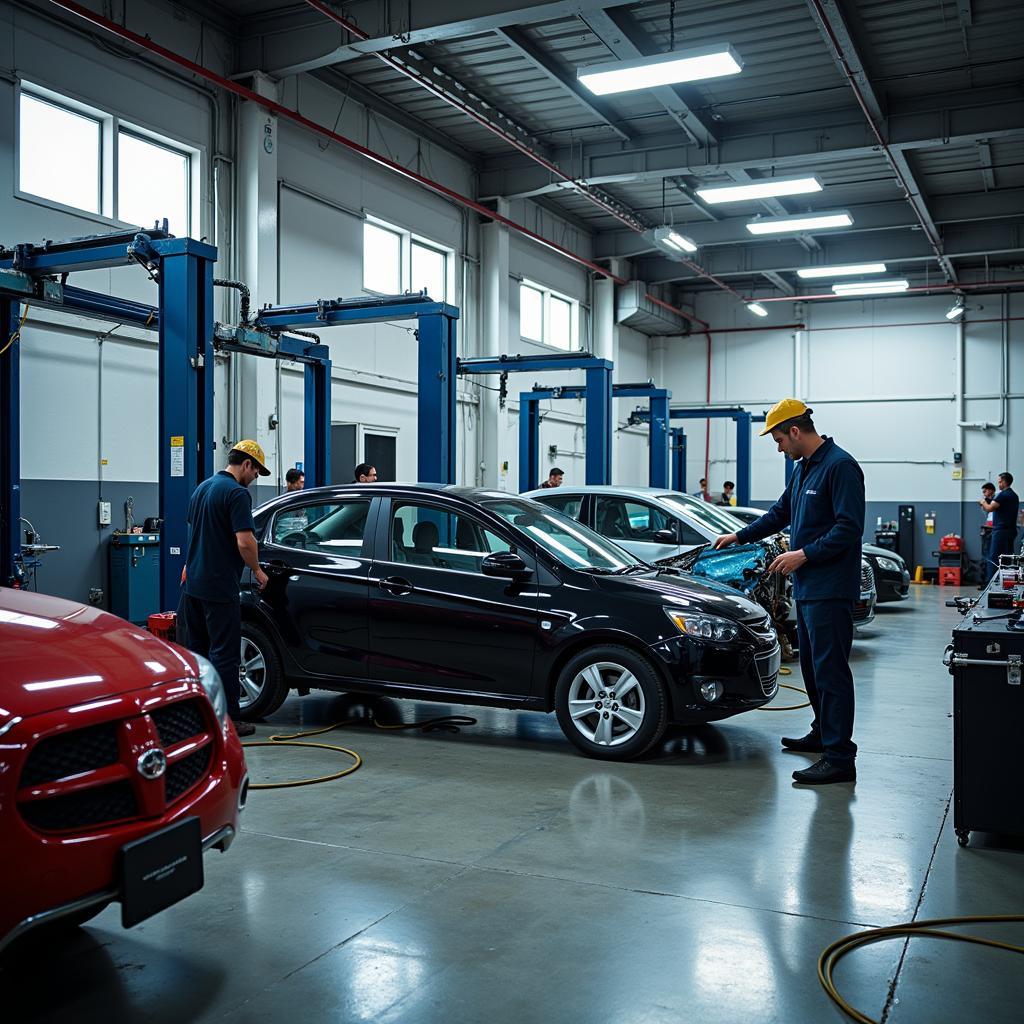Car body repairs can range from minor scratches to significant collision damage. Knowing how to assess the damage and choose the right repair method is crucial for both your car’s appearance and your wallet. This guide provides a comprehensive overview of How To Do Car Body Repairs, covering various techniques, cost considerations, and DIY options.
Repairing car body damage yourself can be a rewarding experience, saving you money and giving you a sense of accomplishment. However, more complex repairs often require the expertise of a professional. Knowing when to DIY and when to seek professional help is essential. For minor scratches, you can often find DIY solutions. Check out our guide on how to repair scratch on car at home for helpful tips.
Understanding the different types of car body damage is the first step in determining the appropriate repair method. Dents, scratches, rust, and cracks each require unique approaches. Assessing the severity of the damage will help you decide whether a DIY fix is feasible or if professional intervention is necessary. If you’re dealing with hail damage, for instance, you might want to read about how much to repair hail damage to car to get an idea of the potential costs.
Assessing Car Body Damage
Before starting any car body repair, thoroughly clean the damaged area. This allows for a clear view of the extent of the damage and helps you choose the correct repair method. Look for underlying damage that might not be immediately visible, such as cracks in the paint or small dents surrounding a larger impact area.
 Assessing Car Body Damage for Repairs
Assessing Car Body Damage for Repairs
Once you’ve identified the type and extent of the damage, you can determine the necessary tools and materials. For minor scratches, a polishing compound and applicator pad might suffice. Dents might require a dent puller or body filler. More significant damage involving rust or cracks will necessitate more advanced tools and techniques.
DIY Car Body Repair Methods for Minor Damage
For minor scratches and scuffs, polishing compounds can effectively restore the paint’s finish. Apply the compound using an applicator pad and buff in a circular motion. For deeper scratches, touch-up paint can be used to fill in the damaged area. Be sure to match the paint color precisely for a seamless repair. For more information on scratch repair costs, check out how much cost to repair scratch on car.
Small dents can often be removed using a dent puller or by applying heat and then quickly cooling the area with dry ice. These methods require careful execution to avoid further damage. Body filler can be used to fill in deeper dents before sanding and repainting. Are you curious about dent repair? Check out is dent in cars repair for more details.
When to Seek Professional Help
While DIY repairs can be cost-effective for minor damage, more extensive repairs often require specialized tools, equipment, and expertise. Structural damage, significant rust, and deep cracks should be addressed by a qualified auto body repair professional. For an idea of dent repair costs in India, you can refer to how much does car dent repair costindia.
Professional auto body repair shops have the necessary expertise and equipment to handle complex repairs, ensuring the structural integrity and safety of your vehicle. They can also color-match paint precisely and apply a professional finish that is difficult to achieve with DIY methods.
Maintaining Your Car’s Body
Regular washing and waxing can protect your car’s paint from the elements and prevent minor scratches. Inspect your car regularly for any signs of damage and address them promptly to prevent them from worsening. Protecting your car’s body not only maintains its appearance but also preserves its value.
 Professional Car Body Repair Shop
Professional Car Body Repair Shop
Conclusion
Knowing how to do car body repairs can save you money and keep your car looking its best. By understanding the different types of damage and repair methods, you can make informed decisions about whether to tackle a repair yourself or seek professional help. Regular maintenance and prompt attention to minor damage can prevent more significant problems down the road, ensuring your car’s appearance and longevity.
FAQ
- Can I repair rust myself? Minor surface rust can be treated with DIY methods, but more extensive rust requires professional attention.
- How do I match touch-up paint to my car’s color? Refer to your car’s owner’s manual for the paint code or consult a paint specialist.
- Is it necessary to prime before painting? Priming is crucial for proper paint adhesion and a smooth finish.
- How long does body filler take to dry? Drying times vary depending on the product and environmental conditions, but typically within 30 minutes.
- What safety precautions should I take when doing car body repairs? Always wear appropriate safety gear, such as gloves, eye protection, and a respirator when working with chemicals or power tools.
- How can I prevent rust on my car? Regular washing, waxing, and undercoating can help prevent rust.
- How do I remove a dent without damaging the paint? For small dents, a dent puller or the dry ice method can be effective if done carefully.
Common Car Body Repair Scenarios
- Scenario 1: Minor scratches from tree branches. Solution: Polishing compound and wax.
- Scenario 2: Small dent from a shopping cart. Solution: Dent puller or dry ice method.
- Scenario 3: Deep scratch with exposed metal. Solution: Touch-up paint and clear coat.
- Scenario 4: Significant dent with cracked paint. Solution: Professional body repair.
Further Reading and Resources
For more information on related topics, please see our articles on:
- How much cost to repair scratch on car
- How much to repair hail damage to car
Need Help with Your Car Body Repair?
Contact us via WhatsApp: +1(641)206-8880 or Email: [email protected]. Our 24/7 customer support team is ready to assist you.


